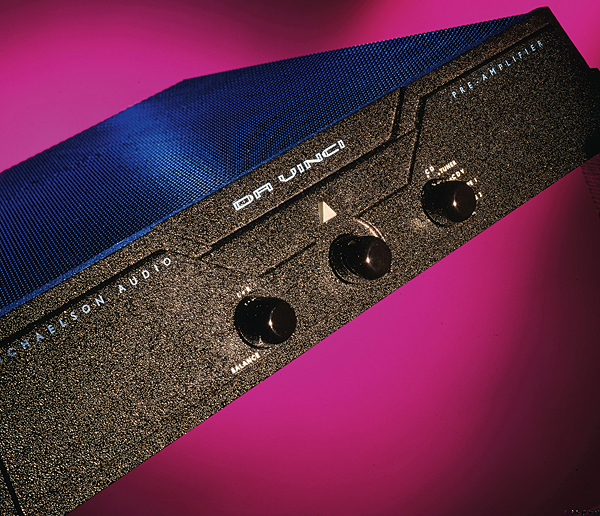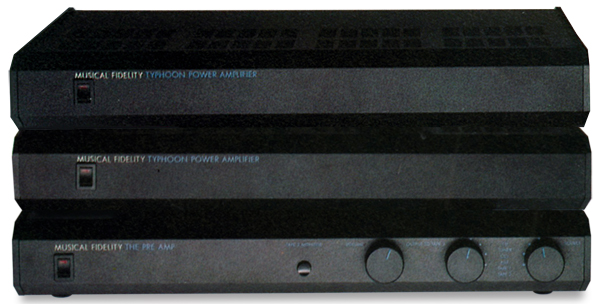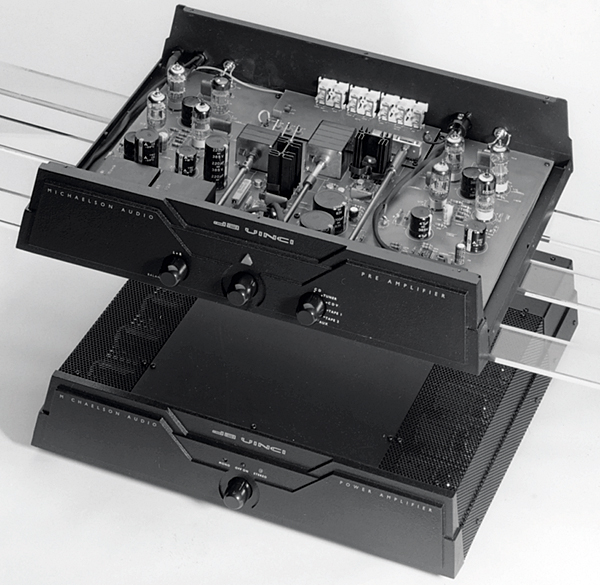Transistors Versus Tubes Page 2
As a package, the Da Vinci moves the goal posts for sub-£2000 all-valve set-ups. Homegrown rivals are numerous, with Croft, Art Audio, Tube Technology and others fighting with superb offerings in the same arena, but the Da Vinci may have the edge on sheer gutsiness.
Preamp And Typhoon
Then again, you may want to save bags of money with the latest in a series of ludicrously underpriced wonders, an amplifier equivalent of the AR M1. It's not in Antony Michaelson's nature to release loss leaders, so I was curious as to how he managed to deliver any separates for under £500, let alone good ones. Again, it's back to his almost Nietzschean approach, one which is gonna drive other manufacturers either to drink or to their pocket calculators.

Formula For Change
Once you get beyond The Preamp's and Typhoon's chassis – same as the B1 amp and therefore not requiring any new tooling – you have to look at the Michaelson Formula for amplifier costings, which may be sheer genius or a work of fantasy to rival the best of Hugh Lofting.
Having decided that the three elements of good amplifier design are power supply, drive circuit and output stage (capacity and size), he argues that – according to his costings analysis – traditional high-end makers use the following cost break-down for a 'typical' big bucks amp: casework, handles, front panel, etc, 60%; power supply including transformers and capacitors 22%; drive circuitry including PCB and all components 7%; output stage 8%; and finally sundry 5%.
The formula he used with the Typhoon power amp is: casework, handles front panel, etc, 16%; power supply including transformers and capacitors 29%; drive circuitry inc. PCB and all components 9%; output stage 39%; sundry 5%. That only adds up to 98%, which makes it all the more miraculous. Whatever, we find that Michaelson claims to stick more inside than out, and what you get is a classically minimalist combination that has no right to work as well as it does. Because, if I'm not imagining what I heard, it means that everyone – not just the luxury makers – has been holding back.
As Michaelson's stated objective is 'state-of-the-art high-end sound at a modest price', you don't get anything lavish in look or feel. Like the company's B1 and other Musical Fidelity products, the externals are par for the (UK) course. Musical Fidelity products, after Michaelson dispensed with such fripperies as back-lit Perspex and called in an outside designer, look smart and different without lapsing into UK outré. (Remember, the Da Vinci and its ilk are another brand entirely.)
In keeping with a no-frills approach, The Preamp is minimalist without appealing to the masochist. Line-level-only, it offers six inputs as well as a record-out facility, a volume control and on/off switching. But when you look at the back, the phono sockets only accommodate the sources. What gives?
Easy: The Preamp offers balanced output only, the Typhoon balanced input only. The package comes with two meters of cable terminated in XLRs, and you can mix 'em with other balanced-operation gear, but Michaelson wasn't about to increase costs by adding two sets of sockets to accommodate unbalanced operation. And balanced operation is a key part of the formula.

The Typhoon, too, is frill free, but it can be converted from 45W/channel at 8ohm to an unstated bridged mono spec by using special adapter cables. With a single stereo Typhoon costing only £299, upgrading with a second amp for either more power or true bi-amping is not an unreachable goal. Whatever the power rating, Michaelson said it will give any 200-watter a run for its money.
High Drama
And that's how I found myself using a £500 pre/power, plus combination, plus an extra Typhoon, between a £5000 CD player and £7000 speakers. At his insistence. And, much though it hurts me to agree with such a hypemeister, I've gotta say... hot damn!
No, it's not quite the Krell-eater Michaelson would like it to be. And it doesn't eat the Da Vinci, either, for that matter, the tube package having far more grunt, greater transparency, a better soundstage and considerably more bass extension. But The Preamp/Typhoon combination does things I never expected to hear for £498 inc. VAT, while a two-amp package for another £299 delivers convincingly 'high-end' scale and drama, if not quite the detail and refinement.
It'll inspire any lapsed audiophiles who have left the fold because of personal financial embarrassment or disgust with escalating prices. And worse for makers and lovers of exotica, it will give the nouveau pauvre-types, the anti-high-enders all sorts of anti-luxury ammunition.
Quite simply, a single Typhoon is powerful enough to drive hungry speakers, while The Preamp is clean enough to route and amplify source signals without much degradation.
Wreaking Havoc
In short, the two Musical Fidelity pieces work perfectly together, the designer having tailored the pair to produce solid, palpable bass, a clear and open midband and fast, extended, fatigue-free treble. And every time you find some little area which you think could do with improvement, you slap your wrist and remind yourself that the set-up with both units only costs £498.

While Michaelson would like to believe that it will steal sales away from Levinson, Rowland, Threshold and the like, this will never happen. I don't care if it's ego, macho fixation, terminal audiophilia or a genuine belief that it takes high-end money to get high-end sounds, but those with the means will continue shopping in Cello-land.
Instead, I expect The Preamp/ Typhoon to wreak havoc in the £400-£1500 sector, even with those consumers who don't expect £10k's worth of performance. At the same time, the pairing will make all sorts of high-end wannabees very happy, mainly those who can't even entertain the idea of five-figure systems. And what they'll unpack when they get home is a superb little set-up which is rough around the edges but fundamentally musical and utterly 'capable'.
The cost-cutting necessary to produce the Typhoon/The Preamp means that the two pieces can be tweaked with great success, eg, a pair of Flux Dumpers and some trick speaker cables working wonders in a couple of areas. This package responds to fine-tuning and hi-fi lunacy like a puppy offered a biscuit, so I dub the combination 'The NAD 3020 for the 1990s'. And that's about as high a compliment as I can pay it.
Second Wind
And here's a tip: the best way you can spend £1500 for a seriously good CD-based system is the Typhoon/The Preamp, a pair of Spendor's bi-wirable LS3/5A speakers, any one of the myriad 'decent' CD spinners for £400 and £200's worth of stands, cables, Kontak and Flux Dumpers. Then, you can add a second Typhoon when later you locate another £298 for maximum oomph. And you won't miss a damned thing as you save for your Krell/Levinson/Rowland/ Threshold... or Da Vinci.


















































